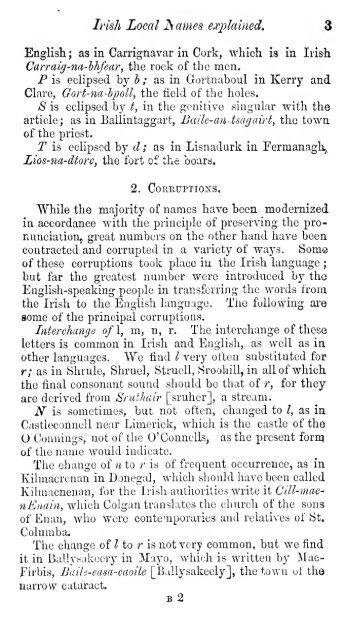Irish local names explained
Irish local names explained
Irish local names explained
You also want an ePaper? Increase the reach of your titles
YUMPU automatically turns print PDFs into web optimized ePapers that Google loves.
<strong>Irish</strong> Local JSames <strong>explained</strong>. 3<br />
English ; as in Carrignavar in Cork, which is in <strong>Irish</strong><br />
Carraig-na-lJifear, the rock of the men.<br />
P is eclipsed by h ; as in Gortnaboul in Kerry and<br />
Clare, Gort-na-lpoll, the field of the holes,<br />
8 is eclipsed by t, in the genitive singular with the<br />
article; as in Ballintaggart, Baih-anUagairt, the town<br />
of the priest.<br />
T is eclipsed by d; as in Lisnadurk in Fermanaghj.<br />
Lios-na-dtorc, the fort of the boars.<br />
2. CoRRUPTIOI7S.<br />
While the majority of <strong>names</strong> have been modernized<br />
in accordance with the principle of preserving the pronunciation,<br />
great numbers on the other hand have been<br />
contracted and corrupted in a variety of ways. Some<br />
of these corruptions took place iu the <strong>Irish</strong> language ;<br />
but far the greatest number were introduced by tho<br />
English-speaking people in transferring the words from<br />
the <strong>Irish</strong> to the English language. The following are<br />
some of the principal corruptions,<br />
IntercJiange of \, m, n, r. The interchange of these<br />
letters is common in <strong>Irish</strong> and English, as well as ia<br />
other languages. We find I very often substituted for<br />
r; as in Shrule, Shruel, Struell, Sroohill, in all of which<br />
the final consonant sound should be that of r, for they<br />
are derived from Snithaii^ [sruher], a stream.<br />
N is sometimes, but not often, changed to I, as in<br />
Castleconnell near Limerick, whicli is the castle of the<br />
OConnings, not of the O'ConncUs, as the present forn^<br />
of the name would indicate.<br />
The change of n to r is of frequent occurrence, as in<br />
Kilraacrenan in Donegal, which should have been called<br />
Kilmacnenan, for the <strong>Irish</strong> authorities write it Cill-macnEnain,<br />
which Colgan translates the church of the sons<br />
of Enan, who were contemporaries and relatives of St.<br />
Columba.<br />
The change of Ho r is not very common, but we find<br />
it in Ballysakeery in Mayo, which is written by Mac-<br />
Eirbis, Baile-ema-caoile [BuUysakeely], the town ut the<br />
narrow cataract.<br />
b2

















